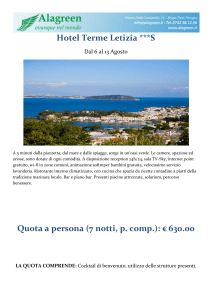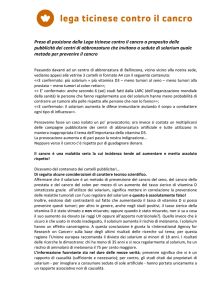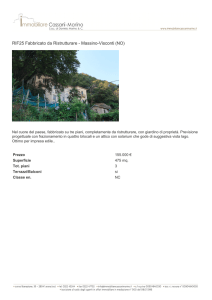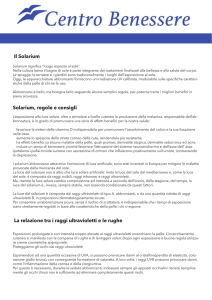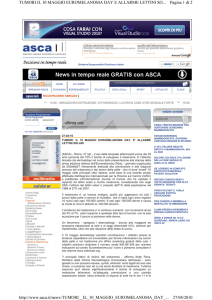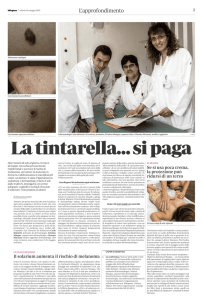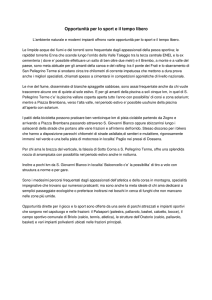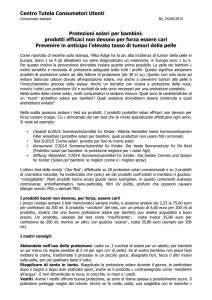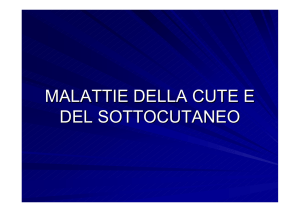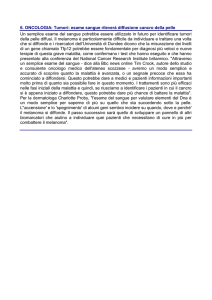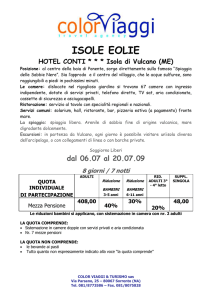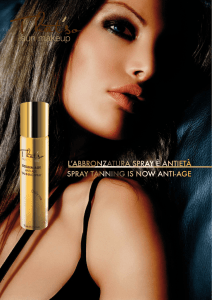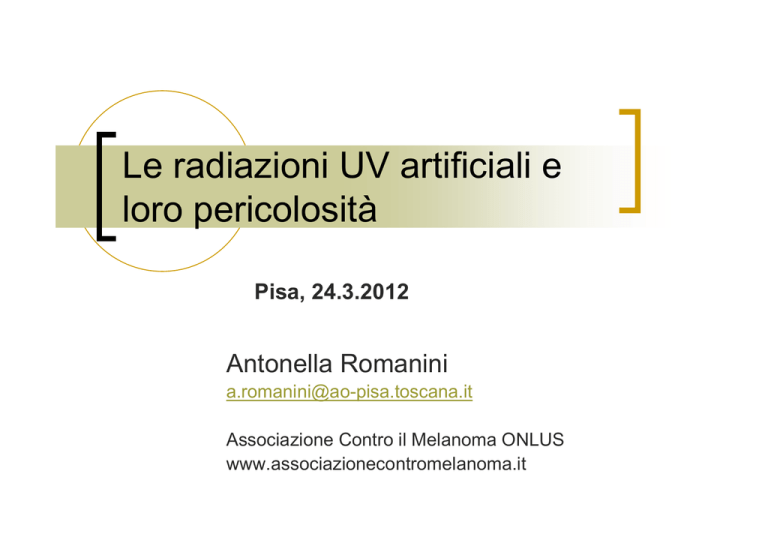
Le radiazioni UV artificiali e
loro pericolosità
Pisa, 24.3.2012
Antonella Romanini
[email protected]
Associazione Contro il Melanoma ONLUS
www.associazionecontromelanoma.it
Radiazioni UV dello spettro
elettromagnetico
Relative erithemal effectiveness
UV radiation represents
about 5% of solar energy,
and the radiation spectrum
is between 290 and 400 nm.
UV Index and Standard Erythemal Dose (SED)
The stratosphere stops 70-90% of UVB
Definizione di lettino solare
Per lettino solare si intende qualunque
equipaggiamento che emette radiazioni
elettromagnetiche con lunghezza d’onda
compresa tra 200 e 400 nm usato per
produrre un’abbronzatura cutanea. Nella
definizione sono incluse le lampade, le
cabine e i lettini solari, mentre sono escluse
le apparecchiature per fototerapia.
Sunburn and Tan acquisition
Skin erythema or sunburns are reported by 18–55% of users of indoor tanning
facilities inEurope and North America (reviewed in Autier,2004).
Although UVB is more potent than UVA for triggering sunburn, high fluxes of UVA
are capable of inducing skin erythemal reactions after 10 to 20 minutes in subjects
susceptible to sunlight and having moderate tanning ability (Fitzpatrick skin
phototype II).
In subjects who tan easily, exposure to tanning appliances will first lead to the
oxidation of melanin already present in superficial keratinocytic layers of the skin
(i.e. immediate pigment darkening [IPD]).
IPD is essentially triggered by UVA (Young, 2004). It develops rapidly after
exposure during an indoor tanning session, and fades away after a few hours.
A more permanent tan is acquired with accumulation of exposure, depending on
tanning ability and on the amount of UVB present in the UV spectrum of the lamps.
The permanent tan conferred by "UVA-tanning" has a uniform and less deep brown
appearance than the tan acquired in the sun.
INDOOR TANNING1
Salon use in <25 year olds
{
College students: 42% – 55% usage
rates
High school students
{
{
1996 - 8%; 2003 - 36%
Males 6 - 44%
Females 30 – 70%
2001: Indoor tanning industry
generated $4 billion in revenues
1 ‐ Scientific and regulatory issues related to indoor tanning. JAAD 2004.
Sole artificiale: quali rischi?
I lettini solari sono stati associati a molti danni alla salute della pelle e degli occhi
{
fotodermatosi
{
Fotosensibilizzazione
{
invecchiamento precoce della pelle
{
tumori cutanei
{
Cataratta
{
Abbassamento dell’immunità
Un crescente numero di evidenze suggerisce che sia responsabile dell’aumento
dei casi di melanoma, specialmente nelle persone che non si abbronzano
facilmente.
La IARC (International Agency for Research on Cancer) ha recentemente concluso
che ci sono evidenze convincenti per supportare il rapporto causa-effetto tra l’uso
dei lettini solari e il cancro della pelle, in particolare se l’esposizione avviene prima
dei 35 anni.
Sole artificiale: quali rischi?
I raggi UV dei lettini solari sono stati classificati come cancerogeni di
Gruppo 2° dalla IARC (International Agency for Research on Cancer) e
questo significa che molto probabilmente causano il cancro nell’uomo.
L’emissione di UV da parte di molti lettini solari è di 10-15 volte
superiore a quella che si verifica sotto il sole di mezzogiorno in molti
paesi del Mediterraneo.
L’uso dei lettini solari a scopo cosmetico non è raccomandato.
Chi farebbe meglio a tenersi alla larga da
lampade e lettini abbronzanti
le persone con pelle e occhi chiari
facilità alle scottature
lentiggini
oltre sessanta nei
storia familiare di melanoma
quanti hanno meno di 35 anni
quanti fanno ricorso a farmaci che aumentano la
sensibilità alle radiazioni ultraviolette (UV)
chi soffre di herpes labiale
chi è affetto da malattie come lupus o vitiligo
I numeri del rischio del sole artificiale
In Europa un lettino solare su sette supera il
livello di emissioni massime consentite.
Nel 78% dei solarium italiani non sono raccolte
informazioni sul tipo di pelle e sulla familiarità per
tumori cutanei.
Il rischio di melanoma aumenta del 75% nei
giovani sotto i trent’anni che utilizzano lampade UV.
Nell’adulto il numero massimo di sedute annuali
non dovrebbe essere superiore a dieci.
Relative risk for cutaneous melanoma associated with ever
use of indoor tanning equipment: estimates of 19 studies and
summary estimate
Relative risk for cutaneous melanoma associated with
first use of indoor tanning equipment at age <35 years:
estimates of 7 studies and summary estimate
False credenze
Il fatto che lampade UV siano utilizzate da dermatologi per la terapia di
alcune malattie cutanee può generare confusione nelle persone e
indurle a credere che il loro effetto sia benefico anche quando non
controllato dal medico.
Una visita dermatologica è inutile a coloro che intendono esporsi a
lettini solari per uso estetico, ma potrebbe fornire adeguate informazioni
sui rischi del trattamento.
L’industria produttrice di lampade reclamizza il loro effetto benefico
sulla sintesi endogena di vitamina D, ma basta mezz’ora di luce al
giorno per coprire il fabbisogno di questa vitamina
Current debate on the health effects of solarium use
Solarium industry claims
Health System responses
Indoor tanning is safer than
outdoor tanning because sunbeds
emit UVA only, which does not
cause skin cancer
There is growing evidence that
UVA is implicated in the
development of skin cancers. UVB
is emitted from most sunbeds to
produce a more lasting tan. Solaria
should be banned.
Indoor tanning is safer than
outdoor tanning because it is
controlled and responsible, and
avoids sunburn.
Sunburn occurs in solarium users,
and there is no way of knowing or
controlling an individual’s
cumulative UV radiation exposure
over a set period. Solarium users
can sunbathe outdoors before and
after indoor tanning, or attend
multiple solaria.
Current debate on the health effects of solarium use
Solarium industry claims
Health System responses
“Pre-holiday tans” are a good idea
as they protect skin from
subsequent outdoor UV radiation.
Tans can be induced by UVA and
UVB. UVB-induced tans provide a
sun protection factor (SPF) of 2–3,
while UVA-induced tans have an
SPF of 0. Pre-holiday tans provide
very little protection from UV
radiation..
Not all UV radiation is bad for you;
its positive effects include
obtaining vitamin D.
Active individuals in Australia are
thought to receive sufficient UV
radiation for vitamin D synthesis in
their everyday pursuits. Compared
with sunlight exposure, solarium
use results in negligible vitamin D
production.
Current debate on the health effects of solarium use
Solarium industry claims
Health System responses
For every study that concludes
that solarium use contributes to
skin cancer, another refutes this.
UVA and UVB are listed as
carcinogens by the World Health
Organization. Solaria are a source
of UVA and UVB, hence can
contribute to the development of
skin cancers. Recent expert
reviews conclude that solarium
use increases melanoma risk.
Australia: How big is the problem?
0.9-3.0% of Australian population used
solaria in 2006.
12% used by adolescents
22-39% regular users
Exposure at age 10-24 important in
melanoma development
In yianger than 35 solaria users the risk for
melanoma is increased by 75%
For the overall solaria users population the
risk increases by 15%
What impact would effective solarium regulation have in
Australia?
Gordon LG et al. MJA 2008; 189 (7): 375-378
Leading international health organisations are concerned about
high use of artificial tanning services and the associated risk of
skin cancer. Similar concerns exist about the growing
Australian solarium industry.
Pre-teens appear to be ignoring sun safety messages in their
desire to tan and use solaria.
A significantly elevated risk of melanoma exists among people
exposed to artificial ultraviolet radiation; the risk is higher for
those younger than 35 years at first solarium use. For all users,
the risk of squamous cell carcinoma is more than doubled
compared with non-users.
What impact would effective solarium regulation have in
Australia?
Gordon LG et al. MJA 2008; 189 (7): 375-378
We estimated the numbers of new melanoma cases and
melanoma-related deaths attributable to solarium use by
younger people in the five most populous Australian
states and indirectly quantified potential costs to the
health system that could be saved by effective regulation
of the solarium industry.
Annually, 281 new melanoma cases, 43 melanoma-related
deaths and 2572 new cases of squamous cell carcinoma
were estimated to be attributable to solarium use.
The annual cost to the health system — predominantly
Medicare Australia — for these avoidable skin cancer
cases and deaths is about $3 million.
By successfully enforcing solarium regulations that ban
use by people younger than 18 years or with fair skin,
favourable health and cost benefits could be expected.
Australia 2004: a voluntary code of practice designed to provide
solarium operators with procedures to minimise the health risks
associated with indoor tanning
banning solarium use by people younger than 15 years or with
fair skin, but allowing people between 15 and 18 years to use
solaria with parental consent;
allowing sunbed emission up to UV Index 60 (five times typical
summer sun);
training on standardised skin-type assessment for solarium
operators;
supervision of solaria by trained operators at all times;
use of client consent forms before tanning.
Failure of self-regulation of the solarium
industry
Five Australian studies have revealed that solarium operators comply
poorly with the Standard, with respect to prohibiting use by fair-skinned
individuals, obtaining informed consent before use, adhering to minimum
age limits and displaying warning signs.
conformity to the technical elements of the Standard (ie, sunlamp
emission intensity, replacement of ageing lamps and operator training) is
unknown.
Furthermore, a contentious point in the Standard is that it allows radiation
intensity levels up to five times those possible from solar radiation.
Failure of self-regulation of the solarium
industry
tests by ARPANSA of 15 sunbeds manufactured in Europe or the United
States, used in Melbourne and Sydney, showed that levels of UV radiation
intensity were equivalent to a UV Index of 15–38 — three times stronger
than the midday summer sun in Brisbane.
Although UVB emissions accounted for 0.4%–2.9% of all emissions, they
accounted for 70%–80% of the erythemal effect. All solaria had higher
total UVB emissions than the midday summer sun in Brisbane, and 30%
had higher UVB emissions in the under-310 nm wavelength range.
Leggi U.S.A.
Sono diverse da stato a stato
27/52 ce le hanno
EU guidelines
The standard states that the verification of conformity
must be performed by:
{
1) determining the ageing of the appliance before
measurement
{
2) respecting a distance of 0.3m.
Recommend that the exposure time for the first session
on untanned skin should correspond to an effective dose
not exceeding 100 J/m2; this is approximately equivalent
to 1 MED for subjects with sun-reactive skin type I.
The annual exposure should not exceed an effective dose
of 25 kJ/m2 (IEC, 1989).
Leggi Italiane
proposta di legge (n. 3116/10) elaborata della Confederazione
Nazionale Estetisti presentata alla Camera dei Deputati il 13
gennaio 2010
nuova disciplina del profilo dell’estetista
nuova figura del “tecnico dell’abbronzatura” con i compiti di
{
notificare le apparecchiature alle Asl
{
firmare e illustrare la nota informativa consegnata ai clienti
{
aggiornare delle schede con il numero di sedute fatte
{
tenere un registro di manutenzione degli apparecchi.
Regolamento Toscano
Marzo 2010
Sconsiglia l’uso dei lettini solari ai
minori senza il permesso dei
genitori
Consiglia una visita dermatologica
prima di far uso dei lettini solari
Prevede la divulgazione di opuscoli
informativi nei centri di estetica
Take home message
L’uso dei lettini solari a scopo
cosmetico non è sicuro.
WWW:ASSOCIAZIONECONTROMELANOMA.IT

